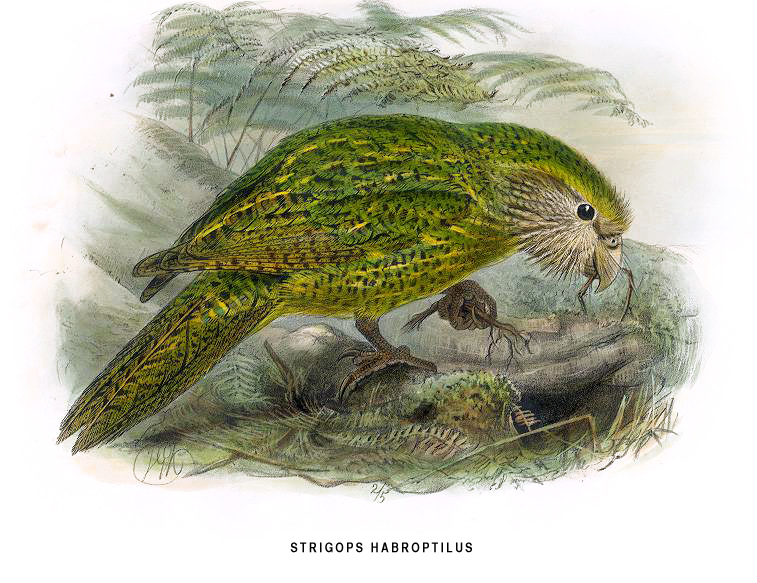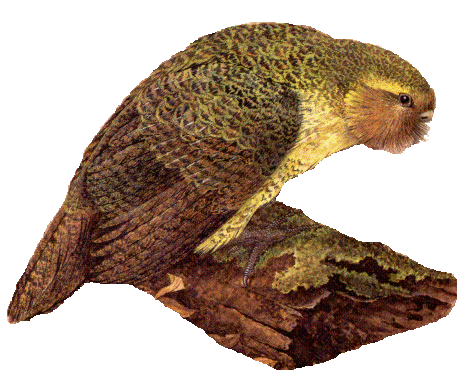Hunt For The Last Kakapo
Posted by: Loren Coleman on March 6th, 2012
The search is on for the last Kakapos.

The Kakapo (Māori: kākāpō, meaning night parrot), Strigops habroptila (Gray, 1845), also called owl parrot, is a species of large, flightless nocturnal parrot endemic to New Zealand. It has finely blotched yellow-green plumage, a distinct facial disc of sensory, vibrissa-like feathers, a large grey beak, short legs, large feet, and wings and a tail of relatively short length. A certain combination of traits makes it unique among its kind—it is the world’s only flightless parrot, the heaviest parrot, nocturnal, herbivorous, visibly sexually dimorphic in body size, has a low basal metabolic rate, no male parental care, and is the only parrot to have a polygynous lek breeding system. It is also possibly one of the world’s longest-living birds. Its anatomy typifies the tendency of bird evolution on oceanic islands, with few predators and abundant food: a generally robust physique, with accretion of thermodynamic efficiency at the expense of flight abilities, reduced wing muscles, and a diminished keel on the sternum.
The Kakapo is critically endangered; as of February 2012, only 127 living individuals are known, most of which have been given names. Because of Polynesian and European colonisation and the introduction of predators such as cats, rats, ferrets, and stoats, the Kakapo was almost wiped out. Conservation efforts began in the 1890s, but they were not very successful until the implementation of the Kakapo Recovery Plan in the 1980s.
The conservation of the Kakapo has made the species well known. Many books and documentaries detailing the plight of the Kakapo have been produced in recent years, one of the earliest being Two in the Bush, made by Gerald Durrell for the BBC in 1962. A feature length documentary, The Unnatural History of the Kakapo won two major awards at the Reel Earth Environmental Film Festival. Two of the most significant documentaries, both made by NHNZ, are Kakapo – Night Parrot (1982) and To Save the Kakapo (1997). The BBC’s Natural History Unit also featured the Kakapo, including a sequence with Sir David Attenborough in The Life of Birds. It was also one of the endangered animals that Douglas Adams and Mark Carwardine set out to find for the radio series and book Last Chance to See. An updated version of the series has been produced for BBC TV, in which Stephen Fry and Carwardine revisit the animals to see how they are getting on almost 20 years later, and in January 2009, they spent time filming the Kakapo on Codfish Island. Footage of a kakapo named Sirocco attempting to mate with Cawardine’s head was viewed by millions worldwide, leading to Sirocco becoming “spokesbird” for New Zealand wildlife conservation in 2010, as part of the International Year of Biodiversity. The kakapo was featured in the documentary series South Pacific (renamed Wild Pacific) episode Strange Evolutions, originally aired on June 13, 2009.

The Kakapo, like many other New Zealand bird species, was historically important to the Māori, the indigenous people of New Zealand, appearing in many of their traditional legends and folklore. It was hunted and used as a resource by Māori, both for its meat as a food source and for its feathers, which were used to make highly valued pieces of clothing. It was also sometimes kept as a pet.

Now this 2012 effort is underway to find them in their old locations:
They are calling it the search for the last kakapo.
A Conservation Department (DOC) team flew to Fiordland – the endangered birds’ last mainland stronghold – in the hope of finding evidence of their existence in historic breeding areas.
The trip was sparked by a credible-sounding report from trampers that the ground-dwelling parrot’s distinctive “booming”, or mating call, was heard in the remote Transit Valley, near Milford Sound, on New Year’s Day.
If audio recorders left on the valley’s rugged ridgelines pick up further booming, it will be the first confirmed sign of kakapo on mainland New Zealand for decades.
Kakapo Recovery Programme manager Deidre Vercoe Scott said the mission was a long shot, but the discovery of new birds would be significant for the population’s recovery.
Once threatened with extinction by stoats, ferrets, weasels and cats, the kakapo is now threatened by poor genetics.
All but three of the remaining 126 birds, living on two predator-free islands, originate solely from Stewart Island stock. Read more, here.

“The species seemed doomed until the discovery of about 200 kakapo on Stewart Island in 1977. However, numbers continued to drop, hitting a low of 51 in 1995,” ends the article.
Thanks for the news tip from Brad Wolfe.
About Loren Coleman
Loren Coleman is one of the world’s leading cryptozoologists, some say “the” leading living cryptozoologist. Certainly, he is acknowledged as the current living American researcher and writer who has most popularized cryptozoology in the late 20th and early 21st centuries.
Starting his fieldwork and investigations in 1960, after traveling and trekking extensively in pursuit of cryptozoological mysteries, Coleman began writing to share his experiences in 1969. An honorary member of Ivan T. Sanderson’s Society for the Investigation of the Unexplained in the 1970s, Coleman has been bestowed with similar honorary memberships of the North Idaho College Cryptozoology Club in 1983, and in subsequent years, that of the British Columbia Scientific Cryptozoology Club, CryptoSafari International, and other international organizations. He was also a Life Member and Benefactor of the International Society of Cryptozoology (now-defunct).
Loren Coleman’s daily blog, as a member of the Cryptomundo Team, served as an ongoing avenue of communication for the ever-growing body of cryptozoo news from 2005 through 2013. He returned as an infrequent contributor beginning Halloween week of 2015.
Coleman is the founder in 2003, and current director of the International Cryptozoology Museum in Portland, Maine.










Another downfall of this species is that it produces a very, very strong musky odor. A scent easily detectable by predators making them an easy target.
That is one method they use to find them, they use specialy trained muzzeled dogs to sniff them out.
Thanks for the story, Loren. I believe Douglas Adams (author of The Hitchhiker’s Guide to the Galaxy) wrote about them in his book, Last Chance to See. Regrettably, the book was one of his last.
Now this is what I like about Cryptomundo.
(Meaty discussions of cryptid evidence, and video-slamming aside.)
Birds like this – and there are, and have been, more such there than anywhere else – were why I went to New Zealand. I knew I wouldn’t see one. But being where they were was what mattered.
Wish I’d been one of those trampers. That mating call is something to hear. To hear it live would be something else entirely.